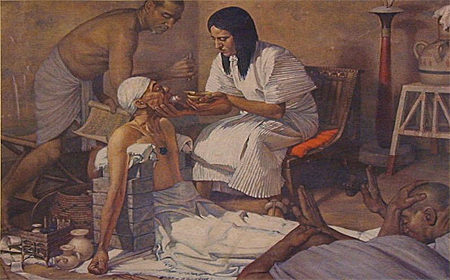
- Articles
A fascinating look at primitive and ancient medicine by medical historian and classical scholar Plinio Prioreschi, MD, PhD
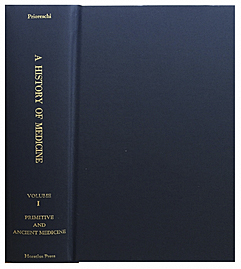
Plinio Prioreschi, MD, PhD (1930–2014), the author of this monumental series of tomes on the history of medicine was an accomplished scholar — i.e., physician, scientist, linguist (of classical and several modern languages), pharmacologist, medical historian, and ethicist, as well as thinker, although he did not necessarily claim all of these accomplishments. Prioreschi completed his MD (1954) at the University of Pavia, Italy, and his PhD (1961) in experimental medicine at the University of Montreal. From 1967 to 2002, Prioreschi was a professor of pharmacology and medicine at Creighton University. He was also an accomplished medical scientist, medical scholar, as well as a formidable figure in pharmacology and medical history and ethics. The complete series of his authoritative series, A History of Medicine, to which he devoted more than 20 years of his life, includes:
- A History of Medicine – Volume I: Primitive and Ancient Medicine (1995); 596 pages
- A History of Medicine – Volume II: Greek Medicine (1996); 771 pages
- A History of Medicine – Volume III: Roman Medicine (1998); 822 pages
- A History of Medicine – Volume IV: Byzantine and Islamic Medicine (2001); 498 pages
- A History of Medicine – Volume V: Medieval Medicine (2003); 804 pages
- A History of Medicine – Volume VI: Renaissance Medicine (2007); 801 pages.
In this study, we will restrict ourselves solely to a brief panoramic review of his first tome — the first step taking us on an enchanting journey into the realm of medical history and ethics. I write enchanting because the book is so well-crafted and so fascinating that the imposing facade and opulence of this first thick volume quickly vanishes by the instructive eloquence of Prioreschi’s prose. What at first glance frightens the reader and whispers to him to put the stout tome back on the shelf, vanishes as the reader begins reading. The narrative soon becomes a delightful obsession, a magnetic read that keeps us turning the pages to see what awaits around the next bend in the magical river! Moreover, Prioreschi’s tomes contain informative footnotes at the bottom of every page that are invaluable to readers and of immense value to researchers.
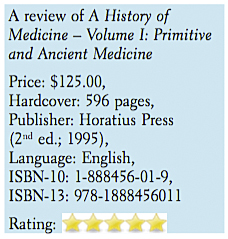
The book delves not only with the immediate subject at hand but also with the interrelated fields — i.e., the history of philosophy, epistemology, science, ethics, and the scientific method, as they relate to medical history. At the outset Prioreschi makes it clear that not until the turn of the 20th century, when the Naturalistic paradigm finally utilized the scientific method and merged theoretical and practical scientific knowledge, did the practice of medicine result in a better than 50-50 chance of helping a patient’s outcome. To this view, he quotes Harvard biochemist Lawrence J. Henderson (1878–1942) who asserted, “Sometime between 1910 and 1912 in this country, a random patient, with a random disease, consulting a doctor chosen at random, had, for the first time in the history of mankind, a better than a fifty-fifty chance of profiting from that encounter.”[2]
Given the terrible odds at the dawn of history, why did primitive and ancient medicine develop and prosper? Why did patients continue to visit shamans, witch doctors, sorcerers, and finally physicians and surgeons in remote antiquity in all parts of the world? Questions such as these are answered with logic and gusto in eloquent narrative and, when applicable, supported with evidence that has reached us through the mist of time. What then is in this book?
The first volume comprises the following subjects and chapter topics: Chapter I — Primitive and Naturalistic Non-Scientific Medicine. Interestingly, this chapter in addition to expounding on primitive medicine in the Neolithic and early Bronze Age, also discusses the ever-present remnants of supernaturalistic medicine (i.e., based on magic, rituals, and religion), which still coexist with modern scientific medicine in the most advanced modern Western and Eastern countries and societies. This is in fact a fascinating chapter, and we should take the opportunity to point out an unusual phenomenon elucidated that has been a subject of discussion by scholars for over a century — i.e., Neolithic skull trepanations (photo, below).[5]
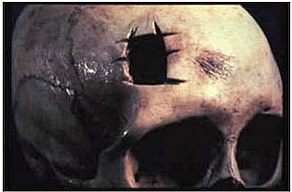
Dr. Prioreschi conducted an extensive analysis in search for an explanation for the uncovering of thousands of mysterious Neolithic skulls with evidence of completed or attempted cranial surgery (i.e., trepanations or trephinations) found all over the world. Employing rigorous deductive logic Prioreschi arrived at an intriguing explanation for this phenomenon, and I believe his hypothesis is correct. A full discussion on this topic, unfortunately, is beyond the scope of this review. I have written a separate paper on this issue in support of Dr. Prioreschi’s conclusionthat trepanations were done in an attempt to resuscitate important members of the hunting group who had recently “died” from illness or small wounds. The reader is invited to peruse my article on this topic [1] and/or read Dr. Prioreschi’s account.[4]
Chapter II — Chinese Medicine. This chapter not only discusses philosophy and moral precepts in ancient Chinese society, but also narrates the advanced state of science and technology that was ahead of the West at this time in antiquity. Herbal medicine and acupuncture are discussed in the context of naturalistic nonscientific medicine. Despite present misconceptions, there is no objective evidence that Chinese herbal, exotic animal and mineral concoctions, or acupuncture had any beneficial medical effects, except as placebo. Prioreschi concludes correctly their alleged benefits are derived in the East largely from entrenched traditional beliefs in the esoteric recipes and additional political pressure added in the case of acupuncture in China. In the West, esoteric novelty, admiration for exotic Chinese culture, and autosuggestion seem to play major roles.[6]
Chapter III — Hindu Medicine. As usual, the historical background is discussed along with the philosophical and religious trends. In the case of ancient India, this pertains to the influence of Hinduism, Buddhism, and Jainism on ancient Hindu philosophy and medicine. Hindu supernaturalistic medicine is compared to naturalistic nonscientific medicine and alchemy. As in other ancient cultures, the two paradigms do not differ in outcome and the benefit of medical treatment is mostly due to placebo effect and autosuggestion.[7]

Chapter IV — Egyptian Medicine. In this chapter, Egyptian history, philosophy, religion, science, and technology are thoroughly discussed. Mummification carried out for religious reasons actually influenced medical practice with the search and use of drugs, resulting in the attainment of rudimentary knowledge of human anatomy and pharmacopeia. Egyptian medicine (photo, left) had some influence on the development of Greek naturalistic medicine as discussed in Volume II of this series. Physiology, as in the case with Hindu medicine, was based on imaginary and fanciful notions, but the Egyptian physicians, unlike all other ancient medical practitioners, did develop a unique pathophysiological concept that will be further discussed later in this review.[8]
Chapter V — Mesopotamian Medicine. Mythology, history, science, and technology, including the development of writing, mathematics, astrology, and astronomy are described, providing a comprehensive background for the development of ancient Mesopotamian medicine. This discussion includes the most salient aspects of the medical and public health practices of the Sumerian, Akkadian, Assyrian, and Babylonian (Chaldean) civilizations.[9]
Chapters VI, VII, and VIII are shorter chapters dealing with Persian, Biblical, and American (Pre-Columbian) Medicine, respectively. Medical practice in these civilizations is described succinctly after elucidating the historical background and the major aspects of the religion of these cultures. For example, Persian medicine is discussed in the context of Zoroastrianism and the influence of the learned magi; Biblical medicine in relation to Hebrew practices, the tenets of Judaism, and the religious teachings and injunctions of the prophets of the Old Testament; the Pre-Columbian medicine of the Incas of Peru, the Mayas of Central America, and the Aztecs of Mexico, as it relates to their ritualistic use of tobacco, psychoactive drugs, their cosmology, and the Meso-American insatiable thirst for human sacrifice, particularly in the Aztec culture.[10]
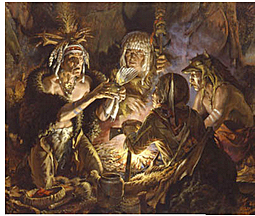
Primitive medicine all over the world first used a supernaturalistic paradigm to explain diseases, injuries, and death. This means that diseases, injuries, and death did not occur at random but were caused by evil deities, offended gods or malevolent demons; violations of taboos; or produced by wicked enemies using magic or sorcery. Treatment therefore was directed toward appeasing deities, using magic and religion with witch-doctors and sorcerers, shamans (photo, left) and priests, and eventually physicians and ancient surgeons.[5]
In time, because of the perceived shortcomings in the supernaturalistic paradigm or because of major crises in the old religions, a new naturalistic nonscientific paradigm was developed to deal with the new existing conditions. This new paradigm attributed diseases to natural causes and not the direct intervention of gods or demons. Therefore natural remedies were sought — i.e., treatment with medicinal herbs, diet and exercise, surgery, and sometimes the use of Dreckapotheke (the application of filthy or disgusting substances, such as the blood and urine of wild animals, and human fluids and feces as medicine or poultices). In Greece, as discussed in Volume II of this series,[3] the naturalistic nonscientific approach was ushered in by Hippocrates of Cos (c. 460–370 B.C.) in the 5th century B.C. But in Egypt, this paradigm was developed much earlier as evinced by the remarkable knowledge of medicine and surgery discussed in the Edwin Smith (1600 B.C.) and Ebers (1550 B.C.) papyri. The evidence supports the view that Egyptian physicians were able to treat fracture dislocations, drain abscesses, and perform minor operations centuries earlier than the Mesopotamians, ancient Chinese, or Greeks — using in some cases mostly a naturalistic nonscientific approach to illness and injury.

In the context of Biblical medicine, it should be pointed out that Hebrew medicine is the only ancient medical system in which supernaturalistic medicine is found strictly within a monotheistic theology (except perhaps for the Zoroastrian religion) and in this same religious context, it is completely and uniquely devoid of other supernaturalistic practices, such as sorcery and demonology, as these practices were strictly forbidden and punishable by death. In all other ancient societies, supernaturalistic medical practitioners included physicians (and frequently priests), sorcerers, quacks and magicians, virtually ministering side by side. This was not allowed in the Biblical medicine of Israel, where only priests and prophets practiced medicine (photo, left); physicians practicing naturalistic medicine were low on the social scale and consulted only as a last resort. Prioreschi takes the time to also expound on the Judaic dichotomy as to the immortality of the soul, a dichotomy that separates Jews to this day.
While in ancient Israel religion was all-important, in China there was no major theology and consequently no state religion. Nevertheless, competing school of philosophies abound, trying to fill in the gap. Supernaturalistic features were nevertheless present from the spiritual world haunting ancient Chinese society. Evil deities affected the world as well as the spirits of ancestors (emanating inauspiciously from the cult of ancestor worship) and had to be propitiated to avoid bad luck, illness, and death. The use of Dreckapotheke was very common in China and in India but it was fairly widespread throughout the ancient world; with the advent of Buddhism, the Four Element doctrine was introduced in China, modified, and became an important feature of Chinese naturalistic medicine.
And this brings us to another salient point in Prioreschi’s thesis, namely the amazing similarities in the fanciful physiological systems the ancient physicians developed in an attempt to explain illnesses and rationalize therapeutics. These similarities were the result of necessary selection from the very limited options available to the ancient physicians. Selecting the most rational option to categorize diseases and institute treatment invariably led to the nearly universal concordance of certain features. For example, one was the need to preserve the balance among several elements and restore the equilibrium of these elements or humors in the body to preserve health or cure illness. Another was the widespread use of laxatives, purgatives, and enemas. The study of the pulse was yet another, particularly for the Chinese and Greeks.
The posited four classical elements of the universe led to the cosmogenic theory that was embraced by many ancient cultures. The four primordial elements were earth, water, fire, and air (or wind). The theory was formally propounded by the pre-Socratic Greek philosopher Empedocles (c. 490–430 B.C.) who also posited the world was dominated by opposing forces (representing love and strife), a universe made up of attractive and repulsive forces that needed balancing. Democritus’ (c. 460–370 B.C.) theory that the universe was made up of component atoms also entered into the cosmogenic theory and ancient physiological notions of the human body as a microcosm of the universe.[3] In fact, Prioreschi noted the notable similarity in most ancient medical systems in the affirmation of the human body as a microcosm of the universe, a body composed of the same minute particles and of the same few primordial elements as the cosmos, the primordial macrocosm.
As we will see in Volume II, the cosmogenic theory of the four elements provided the basis for the theory of the Four Humors of ancient Greek medicine. This Humoral theory, developed in the School of Cos in which Hippocrates played a central role, posited that an imbalance of the four humors — blood, phlegm, yellow bile, and black bile — of the body resulted in disease and illness.[3]
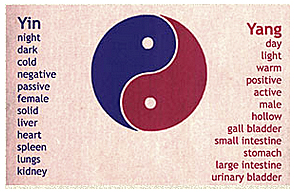
To the theory of the four elements, the ancient Chinese independently modified and added another element (i.e., becoming earth, fire, water, wood, and metal), transformed into the Five Element Doctrine of the universe (and of the body). In addition, Chinese philosophy posited a Yin and Yang, opposite forces that require a proper balance in the universe. In Chinese medicine (photo, left), a proper natural equilibrium in the human body between the five elements and Yin-Yang was essential to preserve health, as well as avoid illness, injury and death. Moreover, a third aspect of Chinese medical “physiology” was the Ch’in (“a rising body vapor” or vital spirit) that flowed in the body and generated energy. It was, in fact, to stimulate the flow of Ch’in (which could be blocked in channels of the body resulting in disease) and reestablish the proper balance of Yin-Yang that acupuncture was developed at about 100 B.C. Very little surgery was done in China, except for cataract surgery (couching) that was imported from India, and castration (for the generation of servile imperial eunuchs needed to administer the imperial civil service). In Hindu supernaturalistic medicine there were also Five Vedic Elements that compose all the matter in the universe and whose properties made up the seven basic substances of the body. Proper equilibrium of the three elements — bile, phlegm, and wind — was also necessary for health in the Hindu naturalistic medicine of the Samhitas.[6,7]
Another interesting feature seen in various medical systems is the Greek pneuma, ill-defined pneumatic principle that flowed in the body and permeated the universe. As we have seen in China, it was the Ch’in. In India it was referred to the vayu (“air”) one of the Five Vedic Elements that permeate nature and was linked to an analogous human anatomy and physiology. For the Egyptians, the ma’at was the cosmic force of harmony and justice that governed the universe. For the Aztecs, the tonalli was the vital force that was related to their fortune and destiny in life as well as their health.
Yet other similarities include the existence of a supreme deity that governs the universe with the existence or the utterance of the Word: Prioreschi noted that the mind of the Egyptian god Ptah had created the universe “by uttering a command,” the Egyptian equivalent to the logos doctrine; for the Greeks, the logos was the word that was God; for the Hebrews, God was also the Word and the Creator of all things, the only healer and dispenser of justice, judging and administering divine retribution; for the Hindus, Brahma, the all-pervading pure consciousness was the ultimate reality, the final cause of all things; for the Persians, Ahura Mazda was the lord of wisdom and the creator and the ruler of the world, etc.

For most ancient civilizations, either the brain, or more likely the heart was the seat of consciousness. Plato thought emotions came from the heart, but that thought was centered in the brain. For the Hindus and the Egyptians the heart was the seat of consciousness and certainly of emotions; for the Mayans and Aztecs the heart was the seat of emotions and thought, and for the Aztecs in particular the heart was all-important for human sacrifice (photo, left). Greek philosophers sided with either Plato or Aristotle, who in turn thought the heart was the seat of thought and sensation. The vast majority of the ancient Greek philosophers agreed that at least emotions were centered in the heart.
A most interesting observation derived from irrigation channels as existing in Mesopotamia, which completely depended on them for agricultural survival, was noted, transferred, and applied to the fanciful notions of human physiology. Thus the idea of vessels carrying fluid unidirectionally in the body most likely resulted from the observation of man-made canals irrigating the soil. Human vessels carried body fluids dissipated in the tissues at the end of the line, including blood, feeding the body in the same fashion as water fed the soil of Mesopotamia and other arid regions. This concept of unidirectional flow was common to the physiological notions of Egyptian, Chinese, Hindu, Mesopotamian, and, as we shall see, Greek physicians, and may have in fact retarded the discovery of the circulation of the blood until the 17th century.
A unique perspective for the source of disease was posited by the Egyptians, and it is worth recounting. As a result of arid conditions in ancient Egypt, natural mummification took place and became the conditio sine qua non for survival of the body after death. The hot dry sand of the Egyptian desert was the best preserver. Humidity, on the other hand, resulted in putrefaction and destruction of the body, whdw (pronounced ukhedu). The ka, the person’s spiritual double and soul, needed a body for survival after death, so the body needed to be desiccated and embalmed to prevent its destruction. The concept of the whdw (ukhedu), Prioreschi elucidated, became the central focus of the Egyptian naturalistic medical paradigm, and it was, in fact, more cohesive and realistic than the humoral equilibrium theory of the Greek, Hindu, and Chinese systems. The enemy of health became feces and decaying material, which became noxious and toxic in the body. Health and longevity depended on the capacity of the body to evacuate putrefying intestinal content. Prompt evacuation of fecal material eliminated putrefaction, prevented the onset of disease, cured illnesses, and prevented aging by eliminating absorption of fecal toxins.[8] It is of interest that purgatives, cathartics, and enemas played a major role in most naturalistic systems but without the conscious adoption of this central concept. This theory of putrefaction as the cause of disease resurfaced, Prioreschi noted, only in the late 19th and early 20th centuries with the doctrine of auto-intoxication. But I believe the concept is still around, and probably still valid, at least in part, in the pathophysiology of colon cancers and acted upon by millions of consumers of supplementary dietary fiber and oral psyllium (Metamucil) on a regular basis!
Many other fascinating discoveries await future readers of Prioreschi’s book, A History of Medicine: Volume I: Primitive and Ancient Medicine, which is, as noted, highly recommended. Dr. Prioreschi, in fact, with his superb scholarship and impeccable research, corrects a number of misconceptions that have gone uncorrected for decades, clarifies points, which have remained murky from time immemorial, and ascertains facts that have not been previously elucidated in medical history and ethics. This book without a doubt places Dr. Plinio Prioreschi, who had been previously unrecognized, as one of the foremost scholars of the 20th century in medical history and, as we shall see in future essays, medical ethics as well.
The word “unrecognized” perhaps requires an explanation and that is that Dr. Prioreschi’s first volume of this, his magnum opus series of medical history, was not even properly analyzed by his peers. For example, a review of this book in a prominent medical history journal read: “The level of detail is most uneven. He [Prioreschi] spends much time on the legend of Gilgamesh and the infective pattern of syphilis, while devoting comparatively little space to all of ancient Greece.”[11] This expert reviewer, after presumably perusing this tome for a critical review, did not even realize that ancient Greece was not formally part of this first volume, but was granted the space of a comprehensive and entire second time in the series! Suffice to say, Dr. Prioreschi deserved better, at least a fair hearing for his effort from his peers in creating this marvelous tour de force in the history of medicine.
Prioreschi’s monumental A History of Medicine: Volume I: Primitive and Ancient Medicine is recommended for initiates as well as scholars and medical historians, and for virtually anyone interested and looking at the subject from a distinct and unique perspective. It is the essential and necessary tome for private as well as public libraries. This tome is highly recommended categorically and without reservations. I have already avidly jumped into the pages of the second volume, Greek Medicine, and so far it is another masterpiece of scholarship and narrative eloquence!
References
1. Faria MA. Surg Neurol Int 2015;6:72 Available from: [Last accessed on 2015 May 10].
2. Lawrence J. Henderson quoted in Prioreschi P. A History of Medicine — Volume I: Primitive and Ancient Medicine. Omaha, Nebraska: Horatius Press; 1995, p. xviii, 11.
3. Prioreschi P. A History of Medicine — Volume II: Greek Medicine. Omaha, Nebraska: Horatius Press; 1996.
4. Prioreschi P. A History of Medicine — Volume I: Primitive and Ancient Medicine. Omaha, Nebraska: Horatius Press; 1995. p. 21‑32.
5. Prioreschi P. A History of Medicine — Volume I: Primitive and Ancient Medicine. Omaha, Nebraska: Horatius Press; 1995. p. 9‑71.
6. Prioreschi P. A History of Medicine — Volume I: Primitive and Ancient Medicine. Omaha, Nebraska: Horatius Press; 1995. p. 73‑193.
7. Prioreschi P. A History of Medicine — Volume I: Primitive and Ancient Medicine. Omaha, Nebraska: Horatius Press; 1995. p. 195‑274.
8. Prioreschi P. A History of Medicine — Volume I: Primitive and Ancient Medicine. Omaha, Nebraska: Horatius Press; 1995. p. 275‑391.
9. Prioreschi P. A History of Medicine — Volume I: Primitive and Ancient Medicine. Omaha, Nebraska: Horatius Press; 1995. p. 393‑453.
10. Prioreschi P. A History of Medicine — Volume I: Primitive and Ancient Medicine. Omaha, Nebraska: Horatius Press; 1995. p. 455‑573.
11. Shapiro C. Review of Plinio Prioreschi, Primitive and Ancient Medicine, Vol. I of A History of Medicine. Lewiston, New York: The Edwin Mellen Press; 1991, in J Hist Med Appl Sc 1994;49:144‑5.
Article written by: Dr. Miguel Faria
Miguel A. Faria, Jr., M.D. is Clinical Professor of Surgery (Neurosurgery, ret.) and Adjunct Professor of Medical History (ret.) Mercer University School of Medicine. He is an Associate Editor in Chief and a World Affairs Editor of Surgical Neurology International (SNI), and an Ex-member of the Injury Research Grant Review Committee of the Centers for Disease Control and Prevention (CDC). 2002-05; Former Editor-in-Chief of the Medical Sentinel (1996-2002), Editor Emeritus, the Association of American Physicians and Surgeons (AAPS); Author, Vandals at the Gates of Medicine (1995); Medical Warrior: Fighting Corporate Socialized Medicine (1997); and Cuba in Revolution: Escape From a Lost Paradise (2002).
This article was originally published in Surg Neurol Int 2015;6:87. https://surgicalneurologyint.com/surgicalint-articles/a-fascinating-look-at-primitive-and-ancient-medicine-by-medical-historian-and-classical-scholar-plinio-prioreschi-md-phd/
This article can be cited as: Faria MA. A fascinating look at primitive and ancient medicine by medical historian and classical scholar Plinio Prioreschi, MD, PhD. Surg Neurol Int 2015;6:87. Available from: https://haciendapublishing.com/a-fascinating-look-at-primitive-and-ancient-medicine-by-medical-historian-and-classical-scholar-plinio-prioreschi-md-phd/
The photographs used to illustrate this book review came from a variety of sources and did not appear necessarily in the author’s book. They were used to illustrate this article for the enjoyment of our readers here at HaciendaPublishing.com.
Copyright ©2015 Miguel A. Faria, Jr., MD